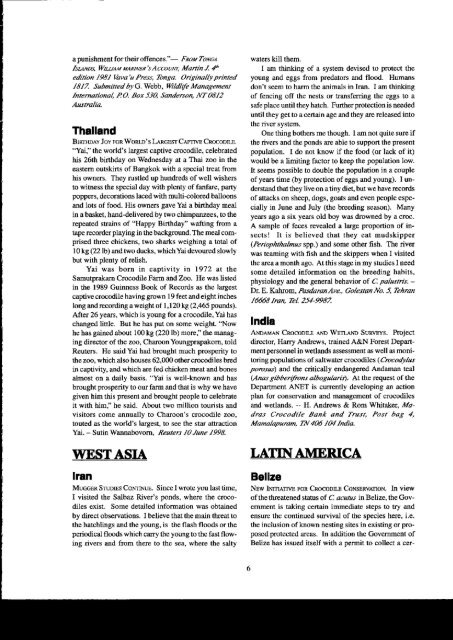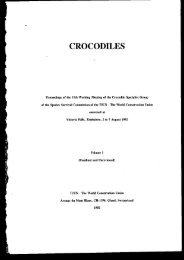size: 1713KB - Crocodile Specialist Group
size: 1713KB - Crocodile Specialist Group
size: 1713KB - Crocodile Specialist Group
Create successful ePaper yourself
Turn your PDF publications into a flip-book with our unique Google optimized e-Paper software.
a punishment for their offences."- Fnott Tored<br />
lst'yups. llttttt,q uanton'sAccou^z', Maftin J. 4<br />
edition l98I Vav.t'u Presr, Tonga. Originally printed<br />
1817- Submined byG.Webb, Mldlife Management<br />
Internalional, PO. Aor fiA Sanderson, NT 0812<br />
Au.rtmlta.<br />
Thalland<br />
BrKrr'rDAy Joy FoR WoRr-D's LARGEST CAI'TIVE CRocoDn-B.<br />
"Yai," the wodd's largest captive crocodile, celebrated<br />
his 26th binhday on Wednesday at a Thai zoo in the<br />
eastem outskirts of Bangkok with a special treat from<br />
his owners. They rustled up hundreds of well wishers<br />
to witness the special day with plenty of fanfare, party<br />
poppers, decorations laced with multi-colored balloons<br />
arrd lots of food. His owners gave Yai a binhday meal<br />
in a basket, hand-delivered by two chimpanzees, to the<br />
repeated strains of "Happy Birthday" wafting from a<br />
tape recorder playing in the background. The meal comprised<br />
three chickens, two sharks weighing a total of<br />
10 kg (22 lb) and two ducks, whichYai devoured slowly<br />
but with plenty of relish.<br />
Yai was born in captivity in 1972 at the<br />
Samutprakam <strong>Crocodile</strong> Fann and Zoo. He was listed<br />
in the 1989 Guinness Book of Records as the largest<br />
captive crocodile having grown l9 feet and eight inches<br />
long and recording a weight of 1 , I 20 kg (2,465 pounds).<br />
After 26 years, which is young for a crocodile, Yai has<br />
changed little. But he has put on some weight. "Now<br />
he has gained about 100 kg (220 tb) nore," the managing<br />
director of the zoo, Charoon Youngprapakom, told<br />
Reuters. He said Yai had brought much prosperity to<br />
the zoo. which also houses 62.000 other crocodiles bred<br />
in captivity, and which are fed chicken meat and bones<br />
almost on a daily basis. "Yai is well-known and has<br />
brought prosperity to our farm and that is why we have<br />
given him this present and brought people to celebrate<br />
it with him;' he said. About two million tourists and<br />
visitors come annually to Charoon's crocodile zoo,<br />
touted as the world's largest, to see the star attraction<br />
Yai. - Sutin Wannabovom, Reuten I0 June J998.<br />
lran<br />
MuccER STLDES CoNTtr\'r,E. Since I wrote you last time,<br />
I visited the Salbaz River's ponds, where the crocodiles<br />
exi6t, Some detailed information was obtained<br />
by direct observations. I bel.ieve that the main threat to<br />
the hatchlings and the young, is the flash floods or the<br />
periodical floods which carry the young to t}le fast flowing<br />
rivers and from there to thc sea, where the salty<br />
waters kill them.<br />
I am thinking of a system devised to protect the<br />
young and eggs from predators and flood. Humans<br />
don't seem to harm the animals in Iran. I arn thinking<br />
of fencing off thc nests or harsferring the eggs to a<br />
safe place until they hatch. Futher protection is needed<br />
until they get to a certain age and they are released into<br />
the river system.<br />
One thing bothers me though. I am not quite sure if<br />
the rivers and the ponds arc able to support the present<br />
population. I do not know if the food (or lack of it)<br />
would be a limiting factor to keep the population low.<br />
It seems possible to double the population in a couple<br />
of years time (by protection of eggs and young). I understand<br />
that they live on a tiny diet, but we have records<br />
of attacks on sheep, dogs, goals and even people especially<br />
in June and July (the breeding season). Many<br />
years ago a six years old boy was drowned by a croc.<br />
A sample of feces revealed a large proportion of insects!<br />
It is believed that they eat mudskipper<br />
(Peiophttu nu.t spp.) ald some other flsh. The river<br />
was teaming with fish and the skippers when i visited<br />
the area a month ago. At this stage in my shrdies I need<br />
some detailed information on the breeding habits,<br />
physiology and the general behavior of C palustis- -<br />
Dr.E.Kahrom, PasdamnAve., Golestan No- 5, Tehran<br />
16668 /mn, Te/. 254-9987.<br />
lndia<br />
Ai\DAMAN CRocoDtr-E AND WETLAT\D SuRVEys. Project<br />
director, Harry Andrews, trained A&N Forest Department<br />
personnel in wetlands assessment a6 well as monitoring<br />
populations of saltwater crocodiles (Crocodylus<br />
poto,tus) utd the critically endangered Andaman teal<br />
(Anas gibberifron,s albogalari,t), At the request of the<br />
Depaxtment ANET is cunently developing an action<br />
plan for conservation and management of crccodiles<br />
and wetlands. - H. Andrews & Rom Whitaker, ly'adrus<br />
<strong>Crocodile</strong> Bsnk and Trust, Port bag 4,<br />
Mamalaauram. 7N 406 104 India.<br />
LAIINAMERICA<br />
Bellze<br />
NEw INnnATrvE FoR CRocoDu CoNsERvATroN. In view<br />
of the thrcatened status of C. acum lnBelize, the Govomment<br />
is taking certain immediate steps to try and<br />
ensure the continued survival of the species here, i.e.<br />
the inclusion of known nesting sites in existing or proposed<br />
protected areas. In addition the Goyemment of<br />
Belize has issued itself witir a pernit to collect a cer-
















